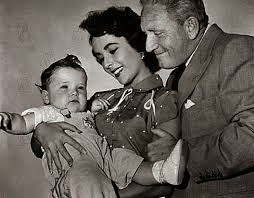Footnote to '50s Career Girls & Marriage
After my last post, I came across some interesting tidbits about working women in the 1950s. The info was too good to let pass, especially since we just explored career women in 1950s movies. According to two books I have been jumping between, married working women were more prevalent in the 1950s than in prior decades. Adrienne McLean in Being Rita Hayworth explains that "between 1950 and 1960 more than four million married women took jobs, accounting for 60 percent of all new workers" (17). In "Old Soldiers Never Die: Father's Little Dividend and the Fading Patriarch," Kristen Hatch provides a more specific detail: "In 1951 a third of American women of working age were in the labor force, and the majority of them were married" (46).
So I checked the U.S Bureau of Labor Statistics (BLS). Sure enough, Hatch's statement regarding the number of working woman was accurate. Per "Labor Force Change, 1950-2050," an article in a BLS journal, "In 1950, the overall participation rate of women was 34 percent" (Toossi 18). This does not, however, indicate how many of the women were married. I continued digging. Another BLS article, "Family Labor Force Statistics" points out that "In 1950, participation rates of wives were much the same as they had been in 1944" (Waldman 17). Contrary to common belief, women did not leave their wartime jobs and crawl back into domesticity.
So why the paradox between movies and reality?
Some might say 34-percent is not a particularly large number, so there is not really a discrepancy. While this may seem like a small amount by today's numbers, I'm sure this seemed like a large percentage at the time. Another thought is that our current understanding of the 1950s woman is derived from Betty Friedan's The Feminine Mystique which is "flawed by its reliance on a handful of conservative writings" (McLean 16). Since I am not familiar with the "conservative writings" in question, I am not comfortable drawing a conclusion based on this theory.
Another possibility for the paradox lies in the very nature of movies. They are fantasies, often the ideal version of ourselves. Hatch hits upon this in her essay: "Our misconception that this was a time of stability with regard to
gender and family life is largely due to the popular domestic comedies
of the period, which created a fantasy of the typical American
family" (Hatch 46).
She further suggests films such as Father's Little Dividend (1951) attempted to preserve an old way of life that was slipping away as women became more financially independent. Whether or not the fantasy was created "to preserve the notion that the typical family is headed by a [male] breadwinner" (49) or the idea that a woman's place is in the home, what remains is a past painted a shade lighter than reality. I am reminded that history is written by the victors and the past is what we create it to be, not necessarily what it actually was. Or in this case, what the filmmakers of the 1950s created it to be.
 |
| Elizabeth Taylor and Spencer Tracy |
Works Cited
Hatch, Kristen. "Old Soldiers Never Die: Father's Little Dividend and the Fading
Patriarch." American Cinema of the 1950s: Themes and Variations. Ed.
Murray Pomerance. Piscataway, NJ: Rutgers University Press, 2005. 46-49.
Print.
McLean, Adrienne. Being Rita Hayworth: Labor, Identity, and Hollywood
Stardom. Piscataway, NJ: Rutgers University Press, 2004. Print.
Toossi, Mitra. "A century of change: the U.S. labor force, 1950-2050."
Monthly Labor Review May 2002: 15-28. Web. 13 Oct. 2014.
Waldman, Elizabeth. "Labor force statistics from a family perspective."
Monthly Labor Review Dec. 1983: 16-20. Web. 13 Oct. 2014.
Patriarch." American Cinema of the 1950s: Themes and Variations. Ed.
Murray Pomerance. Piscataway, NJ: Rutgers University Press, 2005. 46-49.
Print.
McLean, Adrienne. Being Rita Hayworth: Labor, Identity, and Hollywood
Stardom. Piscataway, NJ: Rutgers University Press, 2004. Print.
Toossi, Mitra. "A century of change: the U.S. labor force, 1950-2050."
Monthly Labor Review May 2002: 15-28. Web. 13 Oct. 2014.
Waldman, Elizabeth. "Labor force statistics from a family perspective."
Monthly Labor Review Dec. 1983: 16-20. Web. 13 Oct. 2014.
No comments:
Post a Comment
Note: Only a member of this blog may post a comment.